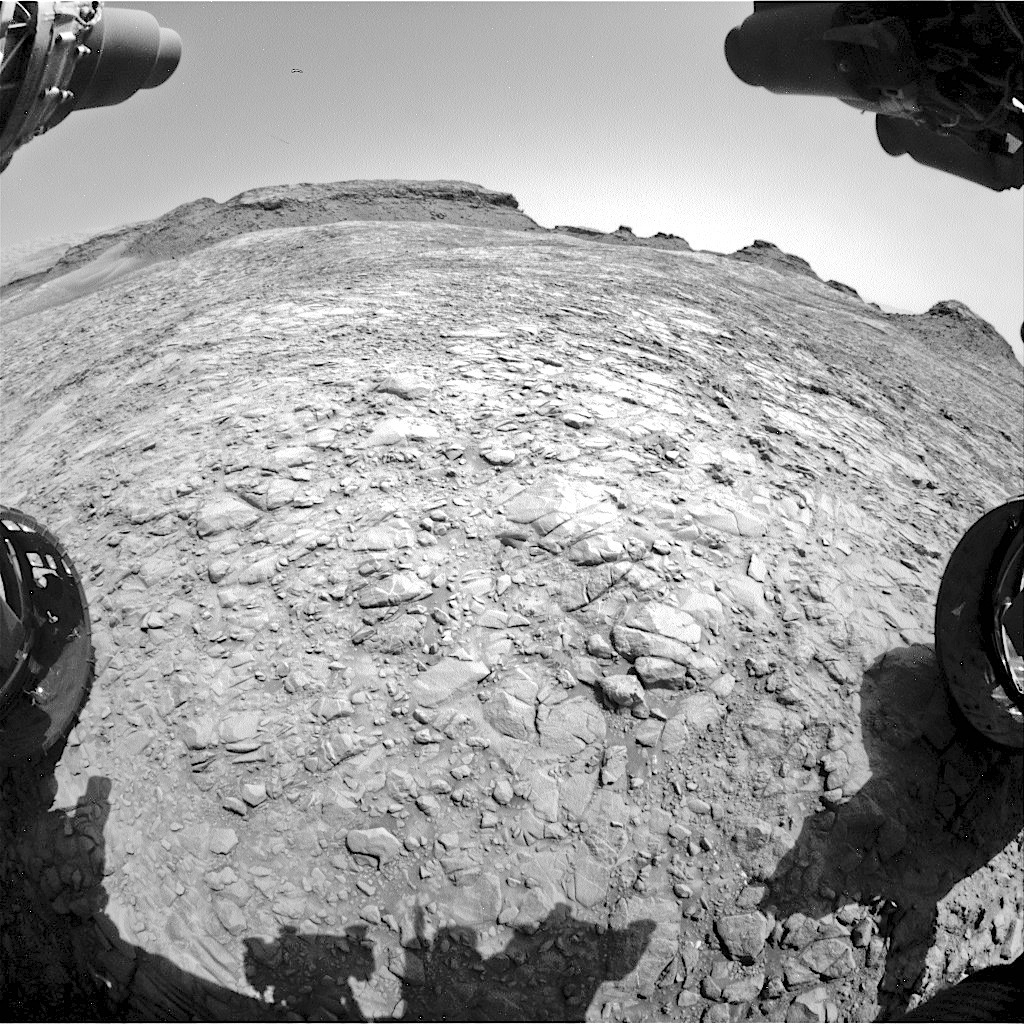 Sol 1412, July 26, 2016. The front right-side Hazcam captures some of the Murray Buttes as they form the skyline in front of Curiosity. Click image to enlarge it.
Sol 1412, July 26, 2016. The front right-side Hazcam captures some of the Murray Buttes as they form the skyline in front of Curiosity. Click image to enlarge it.
Sol 1412 raw images (from all cameras), and Curiosity’s latest location.
 Sol 1412, July 26, 2016. The front right-side Hazcam captures some of the Murray Buttes as they form the skyline in front of Curiosity. Click image to enlarge it.
Sol 1412, July 26, 2016. The front right-side Hazcam captures some of the Murray Buttes as they form the skyline in front of Curiosity. Click image to enlarge it.
Sol 1412 raw images (from all cameras), and Curiosity’s latest location.
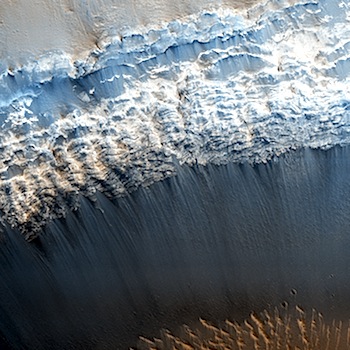 Wall of a crater northwest of Xainza Crater.
Wall of a crater northwest of Xainza Crater.
Beautiful Mars series.
 THEMIS Image of the Day, July 27, 2016. Today’s false color image shows some of the plains of Sabaea Terra. The THEMIS camera contains 5 filters. The data from different filters can be combined in multiple ways to create a false color image. These false color images may reveal subtle variations of the surface not easily identified in a single band image.
THEMIS Image of the Day, July 27, 2016. Today’s false color image shows some of the plains of Sabaea Terra. The THEMIS camera contains 5 filters. The data from different filters can be combined in multiple ways to create a false color image. These false color images may reveal subtle variations of the surface not easily identified in a single band image.
More THEMIS Images of the Day by geological topic.
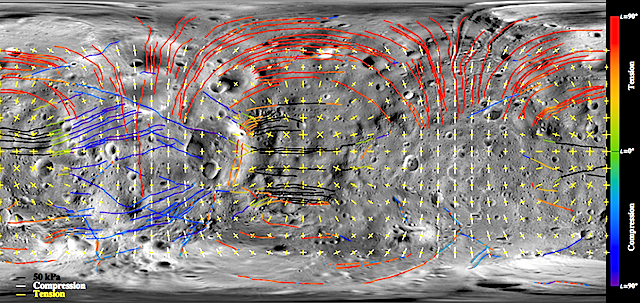 The inner martian moon Phobos is doomed. Scientists have long known that it is spiraling in toward Mars, and will break up from tidal forces before it falls into the planet sometime in the next few tens of millions of years. But a newly published paper says that the tidal forces have already-visible effects.
The inner martian moon Phobos is doomed. Scientists have long known that it is spiraling in toward Mars, and will break up from tidal forces before it falls into the planet sometime in the next few tens of millions of years. But a newly published paper says that the tidal forces have already-visible effects.
Phobos is shaped like a lumpy football, measuring 26 × 23 × 18 km (16 x 14 x 11 miles). It has a large crater, Stickney, on one end and its surface is scarred with a global system of grooves. These are largely symmetric around the side of Phobos that points directly toward Mars.
A new explanation for the grooves says that they are the result of tidal forces at work on Phobos now, and that they are the initial signs of Phobos eventually breaking up. The finding, which is the work of a team led by Terry Hurford (NASA Goddard Space Flight Center), appears in the Journal of Geophysical Research.
Previous work has attributed the grooves to ejecta or seismic shaking from the Stickney impact or to debris swept up by Phobos in its orbit. However, in the new work the team calculated the stress field of Phobos and found that the grooves “show that the first signs of tidal disruption are already present on its surface.”
The researchers note that their computer model requires a weak interior with very low rigidity on the tidal evolution time scale, overlain by an exterior shell some 10 to 100 meters thick. The shell has elastic properties similar to lunar regolith. Most of Phobos’ prominent grooves, they say, “have an excellent correlation with computed stress orientations.” [More at link]
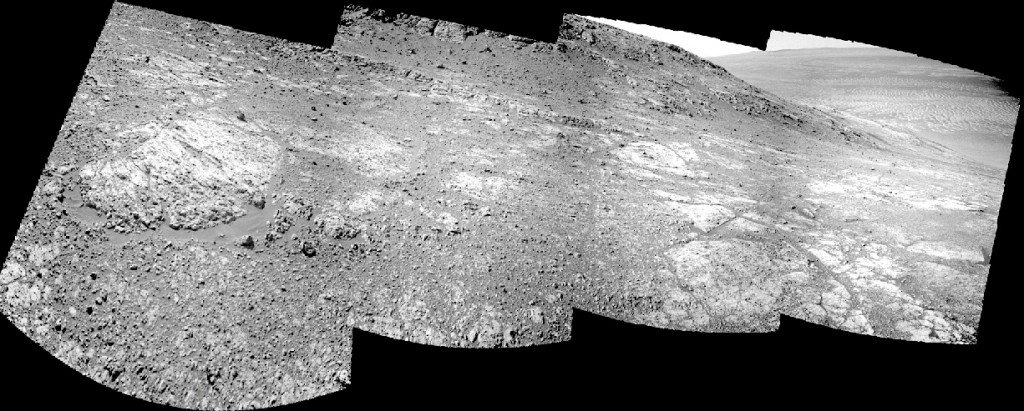
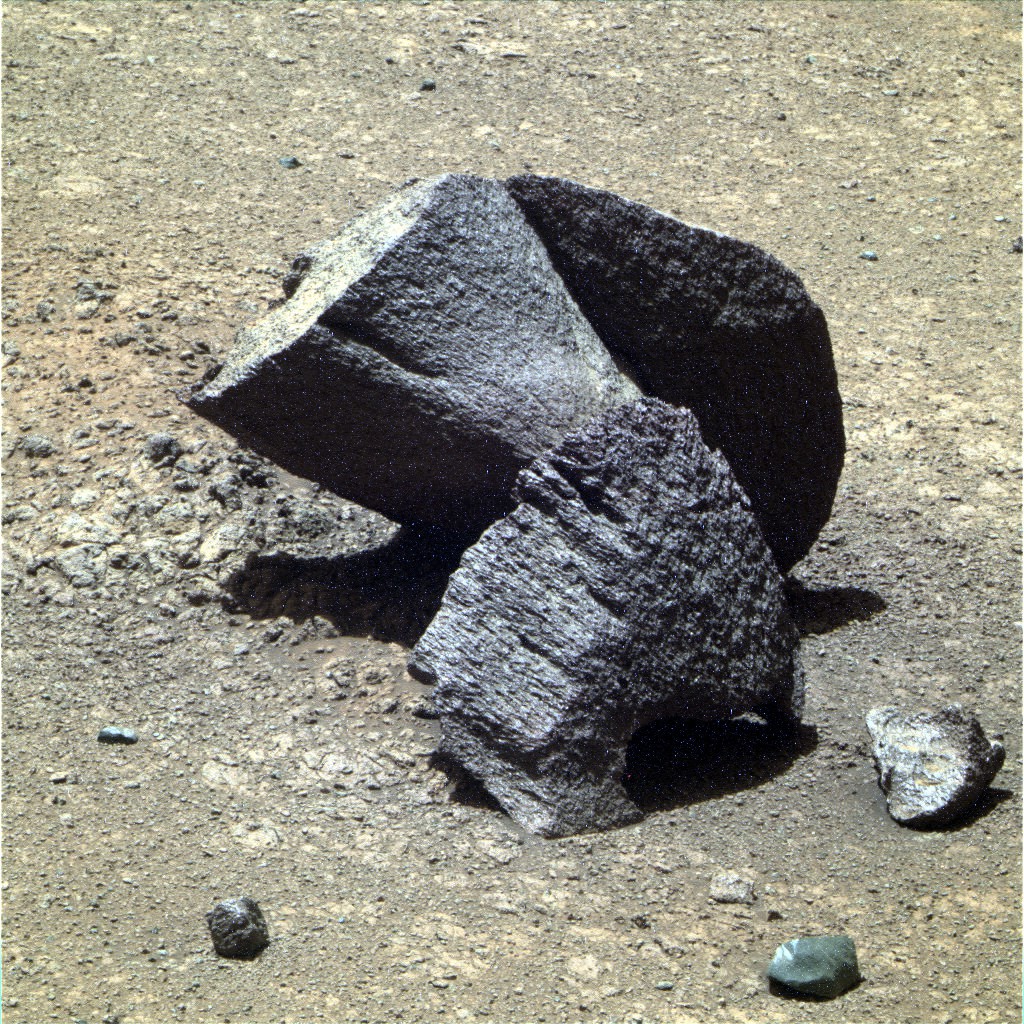 Sol 4445, July 26, 2016. Opportunity turned its Pancam onto a clump of rocks collectively dubbed Sleepy II. (False-color version by Holger Isenberg.) Names here commemorate rocks studied by the Viking landers 40 years ago this summer.
Sol 4445, July 26, 2016. Opportunity turned its Pancam onto a clump of rocks collectively dubbed Sleepy II. (False-color version by Holger Isenberg.) Names here commemorate rocks studied by the Viking landers 40 years ago this summer.
Then the rover drove more than 100 feet (32 meters) to the north, as seen in the Navcam composite above. It will explore along the northern edge of Marathon Valley, descending toward the Endeavour Crater floor. (Click images to enlarge them.)
Opportunity raw images, its latest mission status, a location map. and atmospheric opacity, known as tau.
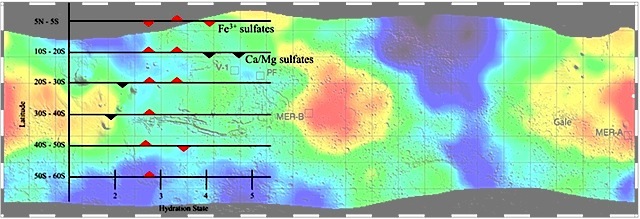 Water is the key to life on Earth. Scientists continue to unravel the mystery of life on Mars by investigating evidence of water in the planet’s soil. Previous observations of soil observed along crater slopes on Mars showed a significant amount of perchlorate salts, which tend to be associated with brines with a moderate pH level.
Water is the key to life on Earth. Scientists continue to unravel the mystery of life on Mars by investigating evidence of water in the planet’s soil. Previous observations of soil observed along crater slopes on Mars showed a significant amount of perchlorate salts, which tend to be associated with brines with a moderate pH level.
However, researchers have stepped back to look at the bigger picture through data collected from the 2001: Mars Odyssey, named in reference to the science fiction novel by Arthur C. Clarke, “2001: A Space Odyssey,” and found a different chemical on Mars may be key. The researchers found that the bulk soil on Mars, across regional scales the size of the U.S. or larger, likely contains iron sulfates bearing chemically bound water, which typically result in acidic brines. This new observation suggests that iron sulfates may play a major role in hydrating martian soil.
This finding was made from data collected by the 2001: Mars Odyssey Gamma Ray Spectrometer, or GRS, which is sensitive enough to detect the composition of Mars soil up to one-half meter deep. This is generally deeper than other missions either on the ground or in orbit, and it informs the nature of bulk soil on Mars. This research was published recently in the Journal of Geophysical Research: Planets.
“This is exciting because it’s contributing to the story of water on Mars, which we’ve used as a path for our search for life on Mars,” said Nicole Button, LSU Department of Geology and Geophysics doctoral candidate and co-author in this study. [More at links]
 Sol 1412-13, July 25, 2016, update from USGS scientist Ken Herkenhoff: MSL is making good progress, driving almost 68 meters last weekend. We had the option of taking some MAHLI images on Sol 1412, but decided to maximize the drive distance instead. Before the drive, ChemCam and Mastcam will observe bedrock targets “Jamba” and “Huambo” and the Right Mastcam will acquire a 3-image mosaic of a small depression called “Mungo.” After acquiring the post-drive imaging needed to plan future… [More at link]
Sol 1412-13, July 25, 2016, update from USGS scientist Ken Herkenhoff: MSL is making good progress, driving almost 68 meters last weekend. We had the option of taking some MAHLI images on Sol 1412, but decided to maximize the drive distance instead. Before the drive, ChemCam and Mastcam will observe bedrock targets “Jamba” and “Huambo” and the Right Mastcam will acquire a 3-image mosaic of a small depression called “Mungo.” After acquiring the post-drive imaging needed to plan future… [More at link]
 A Google hangout was held on Tuesday, 26 July, with ExoMars mission experts and scientists. It included a live Q&A and an update on the cruise to Mars, the crucial mid-course manoeuvre on 28 July and the upcoming preparations for the arrival phase.
A Google hangout was held on Tuesday, 26 July, with ExoMars mission experts and scientists. It included a live Q&A and an update on the cruise to Mars, the crucial mid-course manoeuvre on 28 July and the upcoming preparations for the arrival phase.
Watch the replay:
• On Google+ https://plus.google.com/events/c53judtkn499se8d6ecll9rjo98
• On YouTube https://www.youtube.com/watch?v=MhnrLp1xDnA
Questions were posted using the #askESA hashtag and the best ones were answered live in the hangout.
Since launch on 14 March, ESA’s ExoMars Trace Gas Orbiter (TGO) and the Schiaparelli landing demonstration module have been en route to Mars. This hangout focused on the crucial milestones during the spacecraft’s seven-month cruise to the Red Planet.
The hangout was hosted by Daniel Scuka (ESA Spacecraft Operations Editor) who was joined by:
- Michel Denis, ExoMars Flight Director, ESOC
- Silvia Sangiorgi, ExoMars Deputy Spacecraft Operations Manager, ESOC
- Michael Khan, Mission Analyst, ESOC
- Ian Thomas, NOMAD (spectrometer on TGO) Project Manager, Royal Belgian Institute for Space Aeronomy
[More at links]
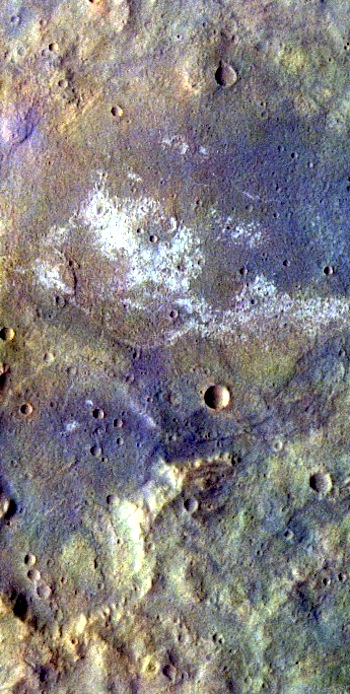 THEMIS Image of the Day, July 26, 2016. Today’s false color image shows some the plains of Terra Cimmeria. The THEMIS camera contains 4 filters. The data from different filters can be combined in multiple ways to create a false color image. These false color images may reveal subtle variations of the surface not easily identified in a single band image.
THEMIS Image of the Day, July 26, 2016. Today’s false color image shows some the plains of Terra Cimmeria. The THEMIS camera contains 4 filters. The data from different filters can be combined in multiple ways to create a false color image. These false color images may reveal subtle variations of the surface not easily identified in a single band image.
More THEMIS Images of the Day by geological topic.
 Hummocky material in Deuteronilus Mensae. Beautiful Mars series.
Hummocky material in Deuteronilus Mensae. Beautiful Mars series.